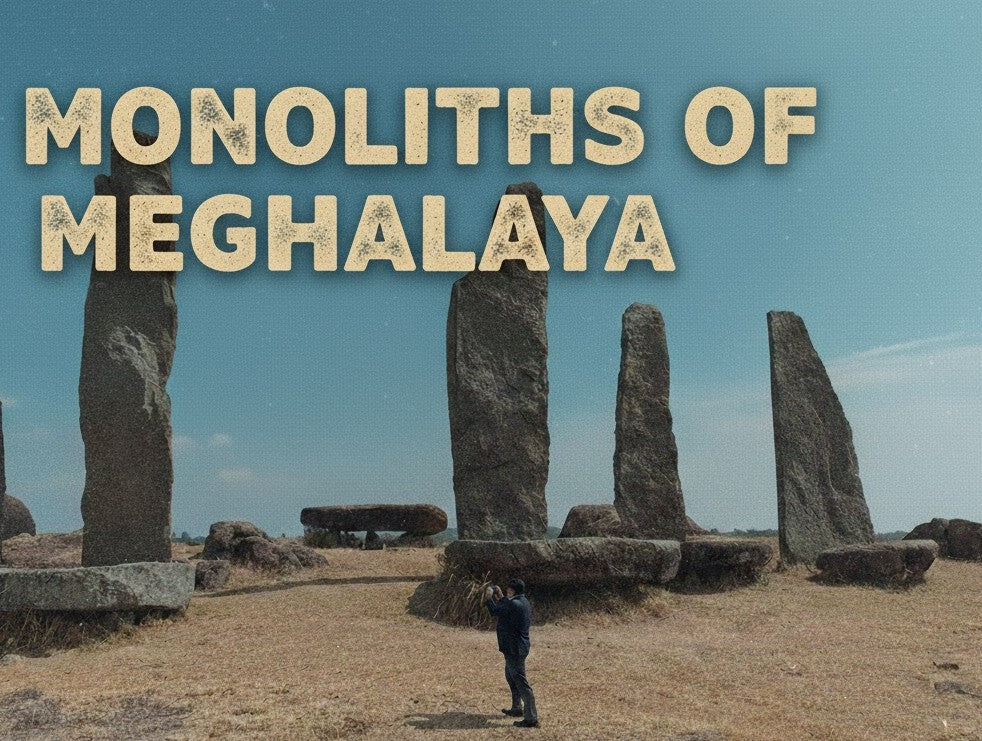The Forgotten Stone Kingdom of Meghalaya: Nartiang Monoliths and Their Untold Stories
Stones That Refuse to Stay Silent
Hidden deep in the misty hills of Meghalaya lies a kingdom unlike any other not made of gold, but of stone.
Here, in the quiet village of Nartiang, hundreds of ancient pillars stand tall, whispering stories of kings, warriors, and families long gone.
These are the Nartiang Monoliths, the largest collection of monoliths in India and one of the most mysterious heritage sites in the Northeast.
The King, the Rain, and the Stones That Wouldn’t Fall
Legend has it that centuries ago, a Jaintia king faced a time of endless rain.
The skies wouldn’t stop pouring, and his kingdom was drowning in despair.
Determined to create something that could outlast the storms, he commanded his people to raise stones so huge that even time itself would bow to them.
These weren’t just monuments they were symbols of strength and defiance.
Each stone was a promise that their memories, their people, and their spirit would never wash away.
The Meaning Behind the Stones
Walk through Nartiang and you’ll notice that the stones aren’t placed randomly.
There’s a beautiful logic behind them:
- Menhirs — the tall, upright stones represent men and warriors.
- Dolmens — flat stones laid across represent women, who were seen as protectors and nurturers.
Together, they create a kind of natural balance, showing how Jaintia society valued both strength and care, power and peace.
It’s rare to find a monument that honors both energies equally but here, you can actually feel it.
Half a Millennium of Strength
Most of these stones are between 400 and 500 years old, dating back to the Jaintia Kingdom.
Some stand more than 20 feet tall, weighing several tons all lifted and dragged uphill by hand.
Imagine entire villages working together, without machines, to raise these slabs of granite — guided only by faith, teamwork, and rhythm.
They weren’t trying to build monuments for show.
They were building memories that could not fade.
The Durga Temple and the Echoes of Power
Just a short walk away from the monoliths is the Durga Temple of Nartiang, one of the 51 Shakti Peethas sacred sites believed to be touched by the goddess herself.
In older times, rituals here were intense, even involving human sacrifices.
Today, that history lives only in stories replaced by symbolic offerings and prayers.
Still, the air around the temple feels ancient, charged with something you can’t quite explain.
You’ll also spot old cannons lying nearby, rusted and silent, reminders of when the Jaintia kings defended their land fiercely from invaders.
Where History Still Breathes
Unlike most historical sites, the Nartiang Monoliths aren’t locked behind gates or ticket counters.
They stand in open air, surrounded by grass and mist, completely at home in nature.
Locals often say the stones are alive that they watch over the village and protect it.
And when the wind blows through them, it really does feel like they’re whispering something ancient.
Every year, during the Behdienkhlam Festival, people from nearby villages still visit the site, carrying wooden poles and singing old hymns.
It’s their way of keeping the connection alive of saying, “We still remember.”
Why These Stones Still Matter
In today’s fast-moving world, where everything changes overnight, the Nartiang Monoliths remind us what it means to stay grounded.
They’ve stood through centuries of storms, empires, and silence —yet they’re still upright.
They teach us that being “upright” isn’t just about standing tall; it’s about staying true — to who you are, where you come from, and what you believe in.
That’s what makes this place more than just a tourist spot it’s a mirror of resilience.
How to Visit Nartiang Monoliths
Location: Nartiang Village, West Jaintia Hills, Meghalaya
Distance: About 62 km from Shillong (roughly a 2-hour drive via Jowai)
Open Hours: 6:00 AM to 6:00 PM
Travel Tip: Stop at Jowai on the way — try local Khasi and Jaintia dishes like pukhlein (fried rice cake), tungtap (fermented fish), and do’o syiar nei iong (black sesame chicken).
Best Time to Visit: Early morning or right after the rain, when the fog rolls in the view is pure magic
Why You Should Go
The Nartiang Monoliths aren’t just stones they’re silent witnesses to centuries of glory and grief.
They’ve seen kings rise and vanish, rituals turn into legends, and faith fade into fog.
People say if you stand among them long enough, you might hear their whispers.
But the truth is you won’t.
You can’t hear the stones anymore, because the world has become too loud.
The silence here isn’t waiting for you it’s warning you.
You wouldn’t understand their language, not anymore.
So don’t go looking for their voices.
They don’t speak to everyone.
Upright will tell you their story — because someone still has to


![The Good Memories [1o8] Meghalaya T-shirt](http://uprightlife.in/cdn/shop/files/IMG_1108.jpg?v=1760226763&width=3840)
![The Good Memories [1o8] Meghalaya T-shirt](http://uprightlife.in/cdn/shop/files/IMG_1101.jpg?v=1760227340&width=3840)
![The Good Memories [1o8] Meghalaya T-shirt](http://uprightlife.in/cdn/shop/files/IMG_1104.jpg?v=1760228003&width=3840)
![The Good Memories [1o8] Meghalaya T-shirt](http://uprightlife.in/cdn/shop/files/IMG_1102.jpg?v=1760228003&width=3840)
![The Good Memories [1o8] Meghalaya T-shirt](http://uprightlife.in/cdn/shop/files/IMG_1112.jpg?v=1760228003&width=3840)
![Menhir and Dolmens [1o8] Meghalaya T-shirt](http://uprightlife.in/cdn/shop/files/IMG_1076.jpg?v=1760226938&width=3840)
![Menhir and Dolmens [1o8] Meghalaya T-shirt](http://uprightlife.in/cdn/shop/files/IMG_1082.jpg?v=1760226938&width=3840)
![Menhir and Dolmens [1o8] Meghalaya T-shirt](http://uprightlife.in/cdn/shop/files/IMG_1080.jpg?v=1760228156&width=3840)
![Menhir and Dolmens [1o8] Meghalaya T-shirt](http://uprightlife.in/cdn/shop/files/IMG_1078.jpg?v=1760228156&width=3840)
![Menhir and Dolmens [1o8] Meghalaya T-shirt](http://uprightlife.in/cdn/shop/files/IMG_1079.jpg?v=1760228156&width=3840)
![Love and Peace [1o8] Northeast T-shirt](http://uprightlife.in/cdn/shop/files/IMG_1048.jpg?v=1760229663&width=3840)
![Love and Peace [1o8] Northeast T-shirt](http://uprightlife.in/cdn/shop/files/11_8ad452b7-1b45-4ea7-9252-a29d69466bd0.jpg?v=1760229663&width=3840)
![Love and Peace [1o8] Northeast T-shirt](http://uprightlife.in/cdn/shop/files/KHASI_Meghalaya.png?v=1760464170&width=3840)
![Love and Peace [1o8] Northeast T-shirt](http://uprightlife.in/cdn/shop/files/IMG_1096.jpg?v=1760464170&width=3840)
![Love and Peace [1o8] Northeast T-shirt](http://uprightlife.in/cdn/shop/files/IMG_1087_2.jpg?v=1760464170&width=3840)